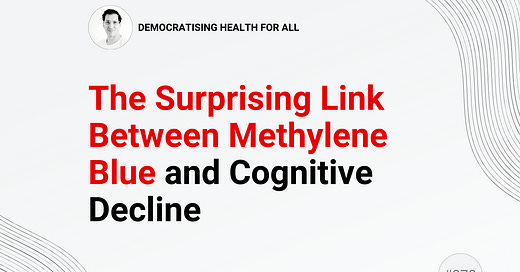Methylene blue (MB) is an organic compound known for its vivid blue colour and wide-ranging applications in various fields, including medicine, scientific research, and environmental science. Discovered in 1876 by Heinrich Caro, it was initially used as a dye before its medical and scientific potentials were recognized. Its chemical structure, C16H18ClN3S, classifies it as a heterocyclic aromatic compound.
Traditionally, MB has been used in medicine as a treatment for methemoglobinemia and as a staining agent in microbiology and histology. It also serves as a redox indicator in analytical chemistry and has shown potential in environmental applications, such as wastewater treatment. Recently, interest has surged in MB for its promising role in ageing research and mitochondrial health, highlighting its potential to impact longevity and cellular function.
Energising Cells and Combating Oxidative Stress
Methylene blue (MB) exerts diverse biochemical mechanisms that underlie its therapeutic effects. Primarily, it enhances mitochondrial function by acting as an alternative electron carrier in the electron transport chain (ETC), thereby promoting efficient ATP production crucial for cellular energy. MB also inhibits nitric oxide synthase, reducing levels of nitric oxide which can impair mitochondrial function at high concentrations.
Furthermore, MB exhibits potent antioxidant properties by scavenging reactive oxygen species (ROS), protecting cells from oxidative stress and damage. This antioxidative action includes hormetic effects, where low doses stimulate cellular defence mechanisms while higher doses may pose toxicity risks. Together, these mechanisms enhance mitochondrial function and bolster cellular resilience against stress.
Compared to other mitochondrial enhancers like Coenzyme Q10 (CoQ10), MB offers unique advantages. While CoQ10 supplements natural coenzyme levels to support mitochondrial function, MB's direct involvement in the ETC potentially provides a more potent enhancement of mitochondrial efficiency. This boost not only increases ATP production but also supports cellular repair mechanisms, crucial for maintaining overall cellular health and function.
Given its ability to mitigate oxidative stress directly by scavenging free radicals and enhancing antioxidant enzymes, MB holds promise in combating ageing and various diseases where oxidative stress plays a significant role. Particularly in neurodegenerative conditions like Alzheimer's and Parkinson's disease, MB's dual action in reducing oxidative damage and supporting mitochondrial health underscores its potential as a neuroprotective agent.
Keep reading with a 7-day free trial
Subscribe to Democratising Health For All to keep reading this post and get 7 days of free access to the full post archives.





